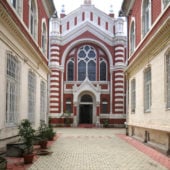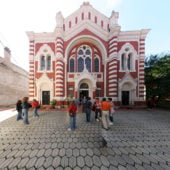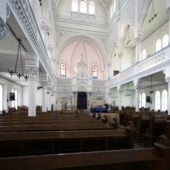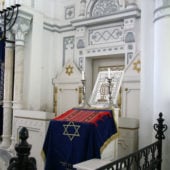Neo-classic in style, this synagogue faces a tiny courtyard near Brasov’s central square.
Brasov Synagogue is a Liberal Synagogue that has literally “risen from the ashes” twice, only to be restored more magnificently than ever before. However, time has taken its toll on the population of Jews in Brasov striking a severe blow to this now struggling community, which seeks to retain its faith, culture and traditions in a city where today assimilation and inter-marriage are more common than uncommon.
Documentation indicates that the first Jewish person to move to Brasov was Aron Lobl, in 1807; however, there is no indication that anyone moved with him. It appears that the next influx of Jews to move into Brasov was in 1826, at which time a law was passed allowing Jews to settle in the town and thus, a community was formed. The initial Jews were plague survivors from Bucharest. Only eleven families were allowed to settle in Brasov at that time and they were selected based on their occupations.
Brasov was run by guilds and the newcomers’ professions had to be such that they would not be competing with those inside the city. There were many other people who tried to enter Brasov, but were denied entry. A small Jewish cemetery for plague victims is located near Catherine Gate. Recently, peoples’ remains were exhumed and transferred to the Jewish cemetery. Over the 75 years following the ruling in 1826, which allowed the initial 11 families into Brasov, the Jewish community grew as a result of marriages and slowly over time, as more Romanian Jews were allowed permission to move in from outside the city. The Jewish community remained largely insular and their leanings were toward Liberal Judaism (similar to today’s Reform Judaism). In 1864 there were 103 people in the community. During that period a secular Jewish school was built. In 1877 a separate Orthodox community was established, although the school served both groups. By the end of the 19th century there were approximately 1200 Jews in Brasov. In 1901 a Synagogue was built which was for Liberal worship, designed by an Austrian Jew, Leopold Baumhorn, who designed many famous synagogues. In 1915 an Orthodox Temple was built. By 1940 there were over 2,000 Jews in the community.
The Synagogue, which began construction in 1898 and completed it in 1901, cost 1.2 million gold kronen. The pipe organ and stained glass windows were destroyed by the Nazis, and the whole building was turned into a warehouse. However, after 1944 the Synagogue was renovated, with the addition of a kosher kitchen and a home for the elderly. The congregants paid for and did the work themselves, under the direction of the leader of the community, Zitrom Aladar. After the 1977 earthquake, the Federation of Roman Jewish Communities helped to restore the Synagogue.
When the Nazis came to power both synagogues were desecrated, Jewish property was burnt, communal property was burned, and children were banned from community school. However, unlike the fate of Jews in most of Europe, the Brasovian Jews were not deported. Few Brasovian Jews were killed during the Nazi reign. Because Brasov was known for being tolerant toward Jews, post WWII, Romanian Jews fled to the city. In 1947 there were nearly 6,000 Jews. Over the following fifty years, the population declined, as many people moved to Israel and the United States. By 1989 the Jewish population had dwindled to about 200. Today, there are approximately 300 Jews, nearly 65% of them over 65 years old. Many of those under 65 years old are married to non-Jews. A large number of the community is only a half or a quarter Jewish. The last Jewish wedding was performed 23 years ago. In the first decade of the 21st century there have only been a handful of bar mitzvahs and there is no rabbi. The current community is small, but is heard in its local government. Services continue to be held every Saturday and on High Holidays.
Brasov is a magnificent Synagogue in a city with a proud history. Though its numbers are dwindling, its community is faithful. They struggle to hold onto their traditions, culture and faith as their community is dwindling.





